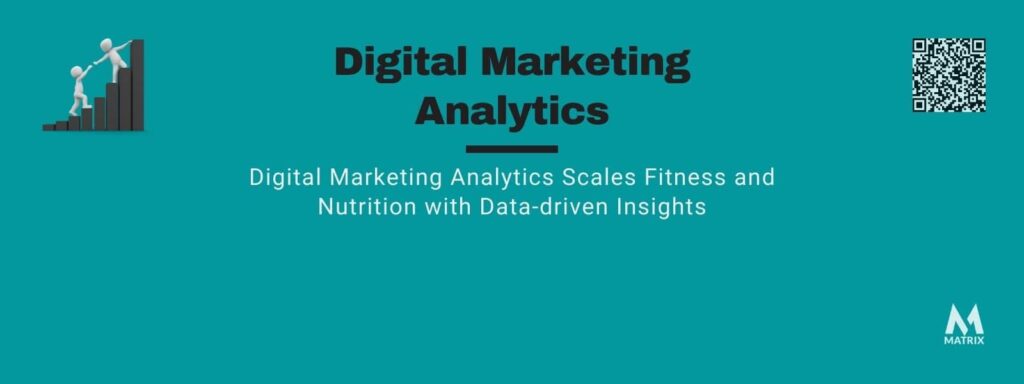Digital marketing analytics show you what works and what does NOT work.
This article is about how digital marketing analytics is one of the most important things you can do as a business owner.
Find out why analytics is so essential and how it will help grow your company with data-driven insights. Learn how to track campaigns, measure ROI, and more!
Digital marketing analytics will allow you to dive deep into your digital strategy and provide insights that help you make better decisions.
You can measure your digital advertising efforts, see what content performs best, learn where customers are coming from and identify the most effective digital marketing channels.
Today, digital marketers rely on digital analytics for just about everything – including understanding what works (and what doesn’t work) with their digital campaigns.
The reason digital analytics is so important is that it gives us insight into our performance to inform future actions that we take.
Whether it’s through learning how to track different digital marketing sources or optimizing conversions by focusing on the customer experience, digital analytics helps us improve our overall approach to achieve success in all areas of digital marketing.
Here are some digital marketing analytics that you can use to help improve your digital efforts
Google Analytics: Track digital campaign performance and behavior for fitness and nutrition
Learn how to track which digital sources and platforms drive the most traffic and conversions (and how to focus on the right ones). Be able to compare organic, paid search, referral, email, and social media.
Keep an eye on on-site interactions like page views, time-on-site, and bounce rates. Use advanced segments for more detailed reports, such as measuring conversion by the device.
Learn how Google Site Search (powered by Google Analytics) lets you learn who’s searching what keywords, then optimize SEO campaigns accordingly. And much more!
Content Marketing Analytics: Measure content performance & ROI

Get more traffic, leads, conversions, and sales from content marketing efforts. Track which digital sources and platforms drive the most traffic and conversions (and focus on the right ones).
Keep an eye on on-site interactions like page views, time-on-site, and bounce rates. Learn what content performs best across different digital channels by measuring digital campaign performance, focusing on getting a complete picture of your digital marketing efforts.
Social Media Analytics: Measure social media performance & ROI
Track social media campaigns across different digital channels. Compare organic, paid search, referral, email, and social media, and more!
See how your audiences engage with posts across Facebook, Twitter, Instagram, Pinterest, and YouTube.
Use advanced segments for more detailed reports, such as measuring digital campaigns by the device. Track digital campaign performance and behavior by focusing on getting a complete picture of your digital marketing efforts.
Customer Experience Analytics: Measure digital experience & ROI

Learn how to keep customers coming back by keeping track of digital touchpoints with customers (online or offline). Measure digital campaign performance and behavior.
Keep an eye on on-site interactions like page views, time-on-site, and bounce rates. Use advanced segments for more detailed reports, such as tracking conversion by the device.
Identify opportunities to optimize conversions with cross-channel attribution so you can see how digital sources influence sales at brick and mortar stores. And much more!
These are just some examples of what digital analytics can help you achieve. The digital marketing landscape changes quickly, so digital analytics is always evolving to meet marketers’ needs.
With digital analytics, you have the power to move beyond gut feelings and opinions instead of using data to inform decisions that will help increase your digital success.
Identify digital marketing channels that perform best for content promotion and discover the most effective types of digital content.
Track social media shares, likes, and comments.
Digital assets attract a lot of attention – then see how many customers click through to your site from each one.
Keep track of inbound links from other websites so you can find out which digital marketing sources drive the most traffic.
You’ll also be able to measure conversions from digital campaigns by tracking metrics like page views, time-on-site, bounce rates, and conversions (including the digital campaign where the conversion occurred).
Why is digital analytics important for fitness and nutrition?

Digital analytics is a core part of digital marketing and digital business.
Without digital analytics, digital marketers would lack the critical information they need to make decisions that will help grow their company with data-driven insights.
With digital analytics, you can learn how to track campaigns, and measure ROI.
What is digital marketing analytics for the for fitness and nutrition companies?
Digital analytics is a digital marketing tool that provides many benefits, and it helps digital marketers measure ROI and digital campaign performance.
Many digital analytics tools to choose from, including Google Analytics, Adobe Analytics, and KISSmetrics.
The digital marketing landscape changes quickly, so digital analytics tools always evolve to meet marketers’ needs.
With digital analytics, you have the power to move beyond gut feelings and opinions instead of using data to inform decisions that will help increase your digital success.
Why is digital marketing analytics important?
Digital marketing influences sales at brick-and-mortar stores and much more!
Without digital analytics, digital marketers would lack the critical information they need to make decisions that will help grow their company with data-driven insights.
With digital analytics, you can learn how to track campaigns, measure ROI, and more. Digital marketing analytics is one of the most important things digital marketers can do to help their digital campaigns perform better.
Digital marketing analytics can help you estimate campaign performance metrics, including return on investment (ROI), attribution, conversion rates, goal completions, etc. Get expert tips for selecting digital marketing analytics tools that are useful in making digital business decisions.
Learn why digital marketers should use Google Analytics as a free digital marketing tool to measure website traffic and user behavior data with goal tracking & event analysis that provides insights into your visitors’ experiences on your site.
Discover what digital marketing is about so you know if it’s right for your company.
What digital metrics should you analyze after a digital marketing campaign has finished?
Digital marketers should use Google Analytics as a free digital marketing tool to measure website traffic and user behavior data with goal tracking & event analysis that provides insights into your visitors’ experiences on your site.
Why is Digital Marketing Analytics Important?

Many digital marketing analytics tools to choose from, including Google Analytics, Adobe Analytics, and KISSmetrics.
The digital landscape changes quickly, so digital analytics tools are always evolving to meet marketers’ needs. With digital analytics, you have the power to move beyond gut feelings and opinions instead of relying on data that is often subjective or outdated.
Identifying digital marketing campaign sources that drive the most traffic is just one example of what digital marketers can do with digital analytics.
You can also learn how to track campaigns, measure ROI, and more – all with data-driven insights. Digital marketing analytics is changing the digital landscape and digital marketers’ work with data-driven digital marketing decisions.
Digital marketing analytics basics include digital marketing metrics, digital marketing tools, and more.
Digital marketers should use Google Analytics as a free digital marketing tool to measure website traffic and user behavior data with goal tracking & event analysis that provides insights into your visitors’ experiences on your site.
What digital analytics is and how it works will also help you understand what digital marketers do.
The Difference Between Analytics vs. Analysis

Digital marketing analytics refers to the data that is collected and processed with digital ads.
Generally, digital marketing analytics can give insights into digital conversions, such as how many people visited the website or how many leads were generated through digital ads.
Digital marketing analysis, on the other hand, reviews digital marketing data to determine which digital marketing strategies are best for achieving business goals and making adjustments accordingly.
What is digital marketing Google analytics?
Digital marketing google analytics is a service that provides digital marketers with insights into digital marketing data. These include the analytics about how digital ads are performing, in addition to digital conversions.
One of the key metrics that digital marketers can use to measure digital performance in Google Analytics includes the “cost per acquisition” metric.
The cost per acquisition metric is useful for determining how much it costs for each new customer acquired through digital channels. This metric can be used to determine which digital marketing efforts are most cost-effective for acquiring new customers.
Benefits of digital marketing analytics

Businesses that use digital marketing analytics reap several benefits over those that don’t. The digital marketplace is a competitive one, and digital marketers need to measure their digital ads, campaigns, and other digital assets to stay ahead of the competition.
Digital marketers can use digital marketing analytics to determine which digital ads generate the most leads, what leads converted into paying customers, and how much it costs them for each customer acquired through digital channels.
What’s great about digital marketing analytics is that there are many platforms available from which business owners can gain valuable insights from data-driven insights.
There are several benefits that digital marketers can gain from digital marketing analytics, including:
- digital marketers can determine customer acquisition costs and digital conversions
- digital marketing analytics provides digital marketers with valuable insights into digital ad performance
- digital marketing analytics allows digital marketers to see which digital ads are producing the most leads
What is a digital marketing dashboard?
A digital marketing dashboard refers to a real-time report that gives business owners an overview of how effective their digital assets are.
A digital marketing dashboard, for example, may give business owners comparative data about different campaigns or messages they’ve recently sent out to see which ones currently have the highest click-through rates.
One of the prime examples of a popular digital advertising platform with robust reporting functionality is Facebook Ads Manager who uses Facebook Ads Manager can track digital marketing performance in real-time, including metrics such as likes, shares, click-through rates, and more.
Digital Marketing Analytics & Data-Driven Insights
There is two key digital marketing analytics that digital marketers must monitor to track digital ad performance:
Digital Ad Impressions
The digital ad impression metric gives digital marketers information about how many people have viewed their digital ads.
Digital Ad Conversions
The digital ad conversion metric helps digital marketers understand how many people who see the ad take action by clicking on it or engaging with it in some way.
It is important for digital marketers to carefully analyze this data over time to improve upon both ad impressions and conversions.
This digital marketing analytics allows digital marketers to determine which digital ad campaigns are most cost-effective and generate the most digital conversions.
In some cases, digital marketing can harm digital marketing analytics.
For example, digital ads that annoy people or that violate brand guidelines may result in “digital ad impressions lost” – essentially meaning that users will be less likely to see future digital ads from the same advertiser again.
This is why digital marketers need to keep an eye on their digital ad performance over time, so they know how best to improve upon their digital assets to grow their business with data-driven insights.
Key Takeaway: Digital marketers must track their various digital ad campaigns using digital analytics to optimize performance and maximize digital ROI.
To learn more, check out this digital marketing guide. This digital marketing guide will help you successfully navigate the digital realm and better understand how to track campaigns, measure digital ad metrics, and more!
Best Metrics for Website Marketing Analytics
The following are digital marketing metrics associated with websites and web activity — a.k.a. web analytics.
Visitor
A Visitor (or User) is someone who visits your website. Visitors are tracked by a cookie placed in their browser by a tracking code installed on your site.
Page View
A Page View is when a browser loads a page on your site, and a page view is measured every time your tracking code is loaded.
Session
A Session is a series of activities taken by a visitor on your website, including page views, CTAs, and events. Sessions expire after 30 minutes of visitor inactivity.
Traffic
Traffic (or Visits) is the total number of site or page visits in a given period.
Traffic by Channel
Traffic by channel is the total number of site or page visits per referral channel (e.g., social media, email, landing pages, etc.).
Traffic by Device
Traffic by the device is the total number of site or page visits per device type (e.g., smartphone, tablet, desktop, etc.).
The ratio of New Traffic to Returning Traffic
The ratio of new traffic to returning traffic is the percentage of the net new site or page visitors you receive compared to the total amount of returning traffic.
Time on Page
The time-on-page is the average time each visitor spends on your site or page.
Interactions per Visit
Interactions per visit are what actions your visitors took when on your site or page.
Bounce Rate
The bounce rate is the percentage of people who visited your site or page but didn’t take any action or look at any other pages compared to the total number of page or site visitors.
Best Metrics for Lead Generation
The following are digital marketing metrics associated with lead magnets and content offers.
Call-to-Action (CTA) Click-Through Rate
The CTA click-through rate is the percentage of total clicks on a CTA compared to the total number of page or site visits.
Submissions
Submissions are the percentage of total people who filled out and submitted your web form.
Conversion Rate
The conversion rate is the total number of actions taken (e.g., a download or sign-up) on your lead magnet compared to the total number of visits.
Free Trial Conversion Rate
The free trial conversion rate is the percentage of free trial users who converted to customers.
Pop-Up Conversions
Pop-up conversions are the percentage of total pop-up form completions that converted to customers.
The ratio of Generated Leads to Marketing-Qualified Leads (MQL)
The ratio of generated leads to MQL is the total number of qualified leads collected from your lead magnet (or landing page) compared to the total number of leads generated.
Leads to Close Ratio
The leads to close ratio is the percentage of leads converted to customers compared to the total number of leads.
Best Metrics for Email Marketing
The following are digital marketing metrics associated with email marketing.
Open Rate
The open rate is the percentage of opened emails proportionated to the total number of emails sent.
Opens by Device
Opens by the device is the total number of email time-on-page opens per device type (e.g., smartphone, tablet, and desktop).
Click-Through Rate
The click-through rate is the percentage of total clicks on an email link, or CTA, the proportion of the total number of emails opened.
Bounce Rate
The bounce rate is the percentage of undeliverable emails as a proportion of the total number of emails sent.
Unsubscribe Rate
The unsubscribe rate is the percentage of people who unsubscribe from your email list over a given time.
Best Metrics for Social Media
The following are digital marketing metrics associated with the content and social media.
Engagement Rate
The engagement rate is the total number of engagements (e.g., comments, clicks, and likes) proportion to the total number of page or post views.
Follows and Subscribes
Follows and subscribes are the total number of people who’ve shown interest in your content and want to receive updates when new posts or pages are published.
Shares
Shares are the total number of times a post or page has been shared on social media, a website, or a blog.
Audience Growth Rate
This refers to the growth of your social audience over time, typically expressed as a percentage. To find it, measure the number of new social followers over a set period (two weeks or a month), divide by your total number of followers, and multiply by 100.
Post Reach
The further your social posts reach, the better for your brand. Digital marketing analytics platforms can show you how many of your social followers have seen your last post. Divide by total followers and multiply by 100 again to get your post reach percentage.
Potential Post Reach
It’s also worth evaluating how far your posts could reach. To find this metric, multiply the number of times your brand is mentioned by the number of followers of the person or brand that mentioned you. The result is your “theoretical reach,” or the maximum number of people it’s possible to reach with your current network. Potential reach is typically two to five percent of this total.
Share of Social Voice
How do your social mentions compare to those of your competitors? Start by searching for mentions of your brand — both the direct @Yourbrand variety and indirect Your brand shoutouts — then measure the mentions of your direct competitors for the same period to see how you stack up.
Approval Rate
While it’s nice to be mentioned, it’s better to be liked. That’s the goal of approval rate measurement — determining how many positive interactions followers have had with your posts. These might include likes, shares, reshares, or even sales conversions, and they can ensure your marketing campaign is on the right track.
Best Metrics for Ecommerce
The following are digital marketing metrics associated with ecommerce.
Shopping Cart Abandonment Rate
The shopping cart abandonment rate is the total number of online shoppers who put items in their shopping cart but don’t complete a purchase as a proportion of the number of people who complete a purchase.
Sales Conversion Rate
More conversions mean more revenue, which means it’s critical to measure your overall sales conversion rate: Out of all customers that visit your site, how many are clicking through to make a purchase?
It’s also worth measuring “mini-conversions” such as moving from home or category pages to specific product pages, indicating positive customer inertia toward sales conversion.
Email Marketing Opt-in
Along with purchasing opportunities, e-commerce sites often contain email marketing opt-ins that provide consumers information about new products or sales events. Measuring your total opt-ins and opt-ins by source (mobile, desktop, or platform) can help quantify marketing efforts.
Customer Acquisition Cost
Customers don’t always come cheap. To find your total acquisition cost, divide the total marketing budget by the total number of customers. The higher the number, the more you’re spending and the narrower your profit margins will be.
Average Order Value
It’s also worth calculating your average order value. Find it by dividing total sales value by the number of carts — the higher the number, the better. Then, look for ways to increase average order value by offering add-on items, bundle discounts, or even free shipping.
Revenue by Source
Where is your revenue coming from? This metric helps identify where your marketing budget is best spent and isn’t working as intended.
For example, if traffic analysis shows substantive sales conversion tied to Facebook followers but almost nothing from Instagram, it’s worth reevaluating your marketing campaign approach.
This section serves as a high-level review of the most important marketing metrics per channel. Depending on what software you use or the marketing channels you pursue, you may see different metrics.
So, why exactly do digital marketing analytics matter? Let’s look at what makes digital analytics so important today and how they compare to (and improve upon) the insights offered by more basic web analytics.
Digital Marketing Analytics vs. Web Analytics
The difference between general web analytics and digital marketing analytics is in their focus. While web analytics provides information about website performance and optimization, digital marketing analytics offer contextual insight into user behavior in your site.
Quite simply, web analytics just isn’t enough. The data that web analytics provides alone doesn’t cut it for marketers who need to understand how their work impacts the entire marketing and sales cycle.
Let’s face it: Today’s marketing extends well beyond the bounds of your website, and it also includes how your marketing channels interact, the insight you gain from those outcomes, and the progress you track through your reporting.
This perspective provides the foundational data you need to structure your demand waterfall — delighting your existing customers enough to attract and engage new ones.
Web analytics measure things a webmaster or technical SEO specialist care about, like page load speed, page views per visit, and time on site. This may require heavy lifting with technical SEO done by an SEO professional.
Digital marketing analytics, on the other hand, measures business metrics like traffic, leads, and sales and allows you to observe which online events determine whether leads will become customers.
Digital marketing analytics include data from your website and sources like email, social media, and organic search.
How Digital Marketing Analytics Connects Every Business Activity
With digital marketing analytics, marketers can understand the effectiveness of their entire marketing strategy, not just the effectiveness of their website.
Using digital marketing analytics allows marketers to identify how each of their marketing initiatives (e.g., social media vs. blogging vs. email marketing) stack up against one another, determine the true ROI of their activities and understand how well they’re achieving their business goals.
The central question is: How can you structure an appropriate business goal to visualize your marketing team’s efforts in the most accurate way possible?
As a result of the information they can gather from full-stack digital marketing analytics, marketers can also diagnose deficiencies in specific sales channels in their marketing mix and make adjustments to strategies to improve their overall marketing activity.
You can spend hours slicing and dicing data in web analytics tools, comparing new vs. repeat visitors month over month. But when it comes down to it, you’ll come up short of a truly comprehensive view of your marketing performance.
There’s no doubt that marketers are aware there’s a deficiency in how they can measure the effectiveness of what they do; here’s how full-stack digital marketing analytics makes up for that deficiency.
How to Use Digital Marketing Analytics Effectively
Most marketers know they need to be looking at more than just traffic and website performance to get the insights we’ve talked about so far. But why do so many of us still struggle to measure the impact and prove the ROI of our online marketing activities?
Probably one of two reasons:
- We don’t have solid goals in place for our campaigns, or
- We don’t have the means to measure our success.
Quite often, you’ll find it’s a combination of the two.
S.M.A.R.T. Goals
Do you have an actionable business goal combining your marketing team’s priorities? Typically, this can be achieved using the S.M.A.R.T. format. In this strategy, each goal you create must be:
- Smart
- Measurable
- Attainable
- Relevant
- Timely
A good business goal will inherently organize your team’s tasks towards producing specific outcomes or metrics to measure their progress. For marketing teams, this can be broadly summarized into three major categories:
- Web traffic and diversity of sources
- Conversions generated from traffic to produce leads and (eventually) customers
- Identifying net new revenue as a direct result of certain marketing efforts, laying a roadmap for further growth and cost-effective marketing investments
The fact is, to gain the insights needed to understand their marketing performance and make sound decisions, most marketers balance several different digital analytics platforms.
Conclusion about digital marketing analytics
We live in a digital world where it is almost impossible not to be connected to the internet. With digital marketing analytics, marketers can identify how each of their marketing initiatives stacks up against one another and determine the true ROI of their activities.
They can diagnose deficiencies in specific channels within their marketing mix that could make them adjust strategies and tactics for improving overall performance. The central question is: How can you structure an appropriate business goal?
To answer this question, there are three major categories web traffic, conversions generated from traffic which leads to generating leads or customers with the hope they become repeat buyers because your efforts were successful enough.
For most marketers today, balancing multiple digital analytics platforms due to lack of insight needed about what’s happening with our online marketing activities.
Wait, digital marketing analytics is a thing?
Yes – digital marketing analytics! You may have heard of digital analytics or web analytics, but digital marketing analytics takes it one step further by incorporating all aspects of digital marketing into one cohesive strategy.
Digital Marketing Analytics is the next-generation approach that incorporates digital metrics across traditional media channels to provide marketers with the insights they need to enhance their campaigns within the digital landscape.
Generally speaking, digital marketers are so busy being on social media all day long trying new tools out there for creating content, etc. Things get lost in translation when it comes down to measuring what is important.
General FAQs
What is digital marketing analytics?
Analytics is digital marketing’s best friend. Setting aside all the reasons why digital makes sense for your company, digital marketing analytics tracks everything else, including which digital campaign is performing the best and why. With this data in mind, you can shift resources where they’re needed most and know if you’re on track toward meeting your goals.
How does digital marketing analytics relate to digital metrics?
The digital marketing and advertising industry adepts know in order to acquire and retain customers, in-depth data has to be at the forefront. Digital marketers rely on digital analytics to track every aspect of their digital campaigns: which channels they use when ads are most successful, conversions rates per channel and so much more. This information is invaluable for making decisions such as how to allocate resources or adjust a campaign strategy
What are the benefits of digital marketing analytics?
The benefit of digital marketing analytics is that digital marketers rely on digital analytics to track every aspect of their digital campaigns: which channels they use when ads are most successful, conversion rates per channel and so much more. This information aids digital marketers in making decisions such as how to allocate resources or adjust a campaign strategy.
Who should be checking their digital marketing analytics reports to know if they are succeeding or failing at digital marketing?
1. As digital marketers, it’s essential to make sure you are constantly measuring your digital performance using digital media analytics.
2) It will give critical insights into how to change strategies when needed based on the data collected–maybe a different offer is necessary or new channels need to be utilized for higher conversions.
3) A digital marketer should know if they’re succeeding or failing at digital marketing by looking at their digital reporting metrics that show how past efforts have helped shape current and future opportunities
4) Using the reports available through Google Analytics, Facebook Insights, etc., enables marketers of any size company to see what content resonated best with users and communities.

